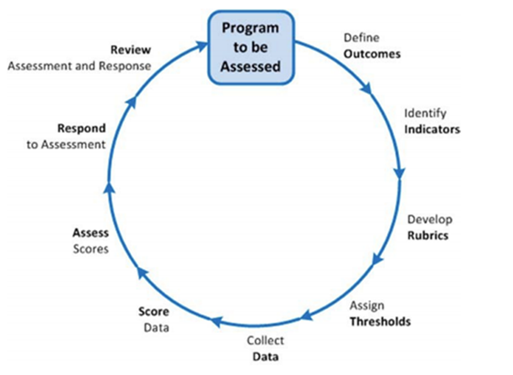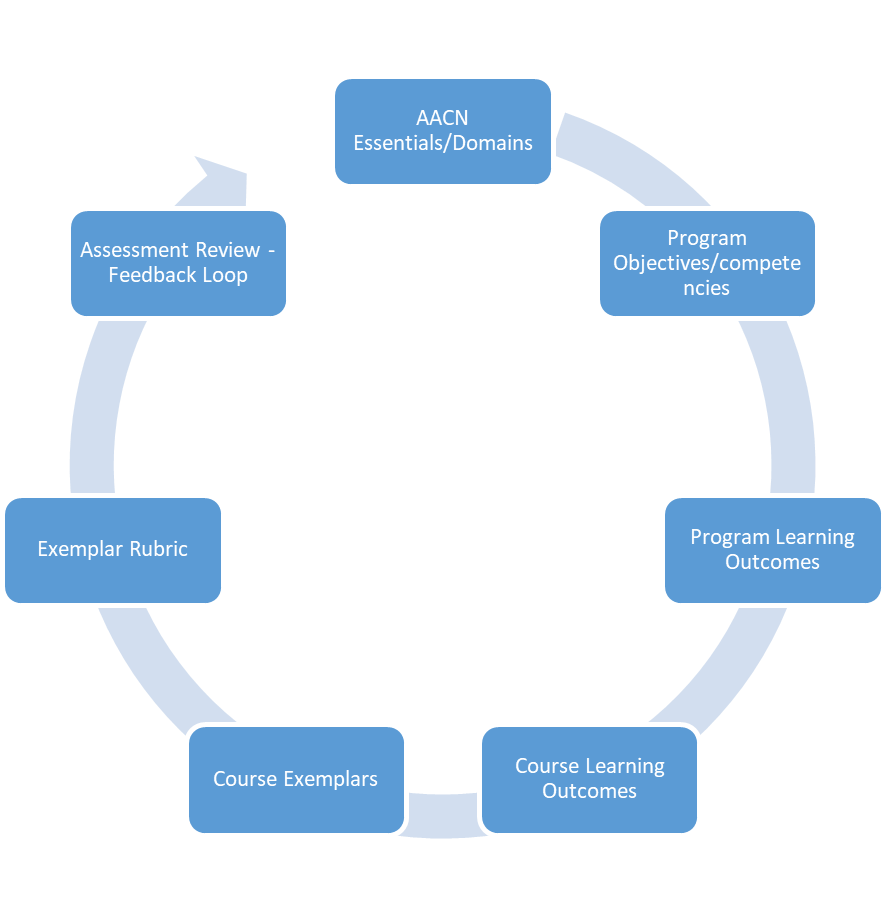Teaching/Learning Program Assessment Plan
Subject: Academic Affairs
Policy: Teaching/Learning Program Assessment Plan
Revised: April 15, 2024, March 2025
Effective date: Summer 2024
Review date: Spring 2028
Responsible Party: Level 1: Executive Council; Level II: Dean
Introduction and Purpose
Consistent with the College of Nursing Master Evaluation Plan and per Commission on Collegiate Nursing Education [CCNE] standards, the Mark & Robyn Jones College of Nursing [MRJCON] engages in ongoing continuous quality improvement which includes program evaluation and curricular assessment of teaching and learning. The two parallel processes support an intentional effort to foster program excellence.
Program Evaluation
The MRJCON identifies defined metrics and thresholds associated with ongoing continuous quality program evaluation as outlined in the Master Evaluation Plan, in particular CCNE Standards IV- A through IV-J (2024). This includes program completion rates, NCLEX and certification pass rates, employment rates, aggregate faculty outcomes, and other identified program outcomes. Faculty use data on program effectiveness to foster ongoing program improvement.
Teaching/Learning Program Assessment
In contrast, assessment of teaching and learning is conducted at multiple levels as outlined in MRJCON Master Evaluation Plan to facilitate a comprehensive review of the curricula and their ability to reflect professional nursing standards and guidelines, the needs of the community of interest, and congruency with expected learning outcomes.
|
Teaching/Learning Assessment Level |
Assessment Process |
Threshold |
CCNE Standard |
|
University Level Assessment |
MSU Assessment & Outcomes Committee reviews all undergraduate programs, degrees, certificates, and minor assessment plans for alignment with university assessment expectations annually, and biennially for graduate programs. Nationally accredited programs submit self-study, mid-cycle reports, and annual Program Assessment Plan to the Provost's office. MSU Core Committee reviews the core perspectives and core qualities for all CORE courses. |
100% of MSU degrees, certificates, and minors are reviewed and/or nationally accredited. |
I-A; I-F |
|
Program Level Assessment |
Master Resource Outline Review – MROs are reviewed every three years, or as needed, by UAAC & GAAC to ensure reflection of relevant professional nursing standards and guidelines, inclusion of both individual and aggregate expected student outcomes, and approval of designated course learning outcome exemplars tied to the Program Assessment Plan. Faculty approve the following MROs elements using track changes: course title, course descriptions, course objectives/learning outcomes and exemplars, course credits, course type, AACN sub-competencies, and recommended content. |
100% every three years. |
III-B, III-C, III-D, III-E |
|
|
Individual Faculty Syllabi Review – IFSs are completed by faculty annually at the beginning of fall semester (or the semester first taught that AY) and reviewed by UAAC and GAAC on a two year cycle (odd numbered courses in odd years and even numbered courses in even years) to ensure compliance with established course description, learning outcomes, learning activities, recommended content, academic policies, and recommended best practices for teaching. |
100% every 2 years |
III-B, III-C, III-D, III-E |
|
|
Established Program Learning Outcomes and associated exemplars are assessed on a scheduled three-year rotation for threshold attainment. Quality indicators of relevance and utility, rigor, independence and objectivity, transparency, and ethics of the student learning exemplar are assessed by two independent faculty reviewers. Recommendations for improvement are reviewed, revised as needed, and approved by the respective academic committee (UAAC & GAAC) for the next assessment cycle. |
100% assessed every three years on a rotating basis. |
III-B; III-C; III-D; III-E & III-L |
|
Course Level Assessment |
Aggregate Course Evaluations (IDEA) ratings reflecting faculty teaching excellence are retrieved from the MSU Center for Faculty Excellence annually per calendar year. Question: “Overall, I rate this course as excellent.” |
75% of all faculty will have an annual mean student faculty evaluation rating of 4.00 or greater (calendar year). |
IV-G |
|
Aggregate Student Survey Data are reviewed by UAAC & GAAC. |
Annually |
III-G |
|
|
Student Level Assessment |
Students are assessed individually by faculty every semester. |
100% of NRSG courses include individual student assessments |
III-K |
Policy
The following defined strategies are associated with ongoing curricular assessment of the MRJCON undergraduate and graduate programs. The defined plan is used to document program assessment, identify areas for improvement, provide information for data driven decision making, and support accreditation efforts [CCNE Standards III-B through III-E, 2024]. The plan is adapted from the MSU assessment cycle. The cycle, illustrated in text, associates program learning outcomes with the identification, scoring, and analysis of specific indicators or course exemplars. The analysis is used to provide feedback on possible improvement and generate reassessment of the planned change.

As it specifically relates to the MRJCON undergraduate and graduate curricula, program learning outcomes [PLOs] are identified and mapped to the AACN Essentials, (AACN 2021), the professional nursing education standards and guidelines that outline the professional nursing domains, concepts, competencies, and sub-competencies for programs providing both entry to practice and advanced nursing practice education. The MN is mapped to the Competencies and Curricular Expectations for Clinical Nurse Leader Education and Practice (AACN, 2013). The DNP APRN programs are aligned with the 2022 NTF Standards for Quality Nurse Practitioner Education (6th ed.) and the Core Competencies for Basic Midwifery Practice (ACNM, 2020). MRJCON PLOs provide the framework for the curricula, individual courses, course learning outcomes, and the development and assessment of individual course learning activities or exemplars. The MRJCON identifies and sets performance thresholds for specific exemplars that reflect the PLOs. Exemplars are assessed and analyzed on a scheduled basis. The analysis and potential recommendations are shared with the Undergraduate and Graduate Academic Affairs Committees on an annual basis. Recommendations are finalized and reported to the MRJCON Executive Committee and MRJCON faculty to close the feedback loop and create a future assessment cycle. Curricula mapping is conducted on a three-year schedule to ensure alignment with nursing standards and to maintain curricula integrity.

Procedures
Faculty Role
1. Faculty conduct an IFS self-review at the beginning of each fall semester (or the first semester the course is taught in the academic year) using the IFS grid found in the cloud-based faculty folders. Faculty update their course syllabi as needed using a standardized syllabus template. The course syllabus is posted to the designated cloud-based folder each semester the course is taught.
2. New faculty will be oriented to the IFS review grid process and the syllabus template by the Campus Director.
3. Course exemplars approved and linked to chosen program learning outcomes (see below in Appendix A) for the program assessment plan are not to be modified without approval from UAAC/GAAC. The data to be collected for each exemplar/learning activity must be retrievable in the course learning module (Canvas) and consistently used across all course sections. Corresponding grading criteria/rubrics and exemplar/learning activity details will be collected from the course syllabus stored in the shared cloud course folders.
4. Closing the Feedback Loop: An annual Teaching & Learning Assessment report is submitted to the faculty and Faculty President at the beginning of the following academic year for discussion and feedback.
5. Faculty approve all MRO and assessment exemplar changes using track change feature. See faculty bylaws.
Campus Director Role
1. The Campus Director orient new faculty to the program assessment plan, IFS grid, syllabus template, and exemplar use.
2. The Campus Director reviews the syllabus and IFS review grid of new faculty prior to the start of the faculty member’s initial teaching assignment and annually thereafter for all faculty during the annual performance review process.
3. Assistant Campus Directors and campus staff monitor and ensure the collection and posting of course syllabi each semester.
UAAC/GAAC Role
1. UAAC/GAAC establishes Program Learning Outcomes [PLOs] for degree and certificate programs and maps them to the AACN Essentials (2021), or as indicated, with an associated exemplar/learning activity and performance threshold value. (See Appendix A).
2. Curricular mapping is reviewed every three years by the designated committee.
3. Individual course mapping is conducted by select committee members and adhoc faculty.
4. The committee reviews IFS grids and course syllabi on a two-year review cycle. Odd numbered courses in odd years and even numbered courses in even years.
5. The academic committee (UAAC/GAAC) reviews MROs every three years on a rotating cycle or more frequently if needed. Changes to MROs and designated assessment exemplars will be sent to the faculty president for general faculty voting and approval with a two-week advance and cover letter.
6. A schedule of planned annual assessments is reviewed by the committee at the beginning of each academic year and used to provide ongoing improvement of teaching /learning outcomes. (See appendix A).
a. The faculty academic affairs committee members review the assessment results and respond accordingly. Possible conclusions include:
i. Gather additional data to verify or refute the result. 5
ii. Identify potential curriculum changes to address the problem.
iii. Change the acceptable performance threshold, reassess.
iv. Choose a different assignment to assess the outcome.
v. Evaluate the course grading rubric. vi. Consider stronger learning outcomes (Bloom’s Taxonomy or other).
vii. Other, describe.
Executive Committee
- An annual report is submitted to the MRJCON Executive Committee following UAAC and GAAC approval for final program review, discussion, any additional recommendations for program quality improvement, and final approval.
Academic Program (AP) Office Role
1. The AP Office oversees the program assessment process and works directly with UAAC/GAAC to facilitate the assessment plan.
2. A population or an unbiased sample of exemplars are collected from the learning management system and tabulated by the Academic Programs office per the assessment plan. The exemplars are not re-graded. The AP Office arranges for the scored aggregate exemplar source data, exemplar assignment, and associated exemplar grading criteria to be assessed by two independent faculty members using the MRJCON Teaching & Learning Assessment Rubric to ensure interrater reliability. (See appendix B).
3. Assessment findings, including areas where the acceptable performance threshold has not been met, are noted and presented to the faculty at the program level (UAAC & GAAC) for recommendations and directly to associated individual course faculty.
4. Upon final EC approval, the summary report is submitted to the MSU Provost's office and postd to the MRJCON website.
5. The AP Office maintains an archived record of course syllabi to facilitate verification of educational records for alumni and accreditation.
Internal control considerations, if applicable: N/A
2025 MRJCON Teaching Learning Assessment Summary Report
2024 MRJCON Teaching Learning Assesment Summary Report
2023 MRJCON Teaching Learning Assessment Summary Report
MRJCON Academic Program Assessment Review (AY 2021-2022)
Appendix A: Program Assessment Schedule
Appendix B: Teaching/Learning Assessment Rubric
References
AACN. (2013). Competencies and curricular expectations for clinical nurse leader education and practice. Washington, DC; Author Retrieved from http://www.aacnnursing.org/Portals/42/AcademicNursing/CurriculumGuidelines/CNL-Competencies-October-2013.pdf?ver=2017-05-18-144336-663
AACN. (2021). The Essentials: Core competencies for professional nursing education. Retrieved from https://www.aacnnursing.org/Portals/42/AcademicNursing/pdf/Essentials-2021.pdf
American College of Nurse-Midwives (2020). Core competencies for basic midwifery practice. Retrieved from https://midwife.org/wp-content/uploads/2025/02/ACNMCoreCompetenciesMar2020_final.pdf
American Nurses Association. (2021) Nursing scope and standards of practice. Silver Springs, MD
Commission on Collegiate Nursing Education (CCNE). (2024). Standards for accreditation of baccalaureate and graduate nursing programs. Retrieved from https://www.aacnnursing.org/Portals/0/PDFs/CCNE/CCNE-Education-Standards-2024.pdf
National Organization of Nurse Practitioner Faculties (2024). Competency implementation guide for nurse practitioner faculty. Retrieved from https://cdn.ymaws.com/www.nonpf.org/resource/resmgr/np_competencies_&_ntf_standards/Revised_Comps_Implementation.pdf
National Organization of Nurse Practitioner Faculties. (2022). Nurse Practitioner role competencies. Retrieved from NP_Role_Competencies_Revised.pdf
National Task Force. (2022). Standards for quality nursing practitioner education, A report of the national task force on quality nurse practitioner education, 6th Edition. Retrieved from https://cdn.ymaws.com/www.nonpf.org/resource/resmgr/2022/ntfs_/ntfs_final.pdf
